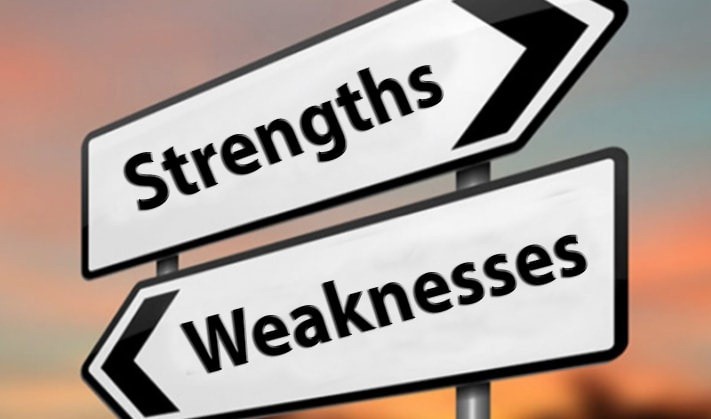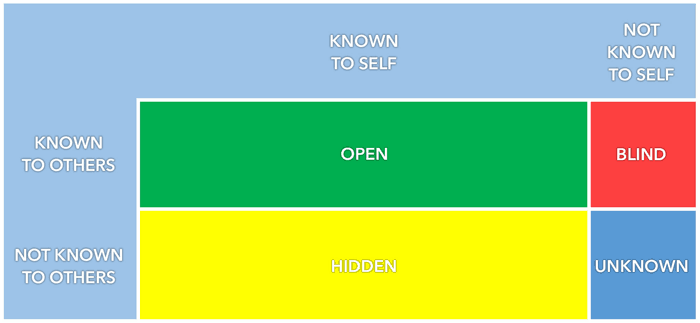Humans are genetically incapable of being honest, with themselves and others. Sadly, we are most dishonest with ourselves. This dishonesty manifests in different ways.
We either have grand perceptions of our own strengths or we pride in our weaknesses. We can realize our full potential, should we ever learn to drop these traits.
In turn, this will help us lead happy, more fulfilling and happier lives in family, work and society.
Good reasons to know your strengths and weakness
By and large, let us work on the premise that humans are incapable of honesty. Unfortunately, that is the reason we all live in a world of self deception. Sadly, this sounds harsh but it is true.
Moreover, our self deception revolves around unrealistic assessment of our own strengths and capabilities. Further, it is aggravated by a diminished sense about our weaknesses.
This imbalance causes major problems in our life. We take challenges such as situations or work that do not suit us. Alternatively, we shy away from circumstances and jobs because we believe we are incapable.
Importance at job interviews
Invariably, a majority of interviewers ask jobseekers this common question “what are your strengths and weakness”. Of course, the interviewer is aware that nobody can enumerate their strengths, leave alone weaknesses, when confronted by such a question.
Some interviewers ask this question to try and understand the level to which the candidate is aware about their own dark and bright sides. However, some ask the question because they do not have better ones.
Regardless of the reasons behind this question, you cannot afford a fumbled response. A confused reply is indicative of lack of confidence and self awareness.
It shows you can fail at several key tasks that may be expected of you at work. Going off balance when facing this common question can mean you are unsure about what you can offer to the employer.
Tweaks for passing a job interview
Considering that one or more questions about your strengths and weakness at interviews is imminent, here are some things you can do at the spur of the moment.
Strengths
- Recall what your parents, siblings or friends praised you for.
- Think about the reasons you do a good act towards strangers. Helping a physically challenged person cross the road, for example, indicates great civic sense and piety.
- Remember your achievements at academics, sports and life. These strengths are usually inborn.
- Mention what you find pleasurable in hobbies. For example, listening to instrumental music indicates a sophisticated taste for fine art.
Weaknesses
- Speak frankly about why you dislike something. Whatever you dislike is not only your weakness, it also indicates strength. Hating injustice means you are just and fair to all.
- Discuss your fears- they are a manifestation of weaknesses. For example, fear of underperforming at work shows you will strive for perfection.
- Talk about your past failures. Honestly, it is great to do that. A failure clearly indicates your weak point. However, accepting a failure shows willingness to recognize the weakness and eliminate it.
- Bluntly state what you can do and what you cannot. Employers and interviewers appreciate honest, up-front approach when you disclose your limits. More importantly, say why you cannot do something.
- Tell about factors that have distracted you and continue to nag till date. It could be an ongoing affair or adverse financial situation.
Indentifying strengths and weaknesses: Tough yet possible
This brings us to the vital question: How to identify my strengths and weaknesses? Indeed, that’s a tall order. Yet, it is possible, despite being tough.
To begin with, you need to be extremely honest with yourself. This is the sole requirement.Further, it means you need to bare yourself to the bone- mentally and on paper.
A true self assessment is the best way to know your strengths and weaknesses. Further, it will help you develop new strengths while reducing or eliminating your weaknesses.
Select the best available technique
Incidentally, several known and proven techniques are available to gauge your strengths and weaknesses. Of these, a few are formal while others are casual and rather easy.
However, using both formal and informal methods to identify your strengths and weaknesses will help immensely.
Seek help from someone you trust
Asking the other about your strengths and weakness offers you a glimpse into your own character, weaknesses and strengths. Therefore, you can approach anyone from the list below:
- School/ college/ workplace counselors
- Psychologists/ psychiatrists/ behavioral therapists
- Parents/ spouse/ close relatives/ neighbors
- Friends/ colleagues/ boss
- Teachers/ educators
Obviously, some answers from these people will most likely be unpalatable. However, they are vital for your personal, professional, social, financial and spiritual growth.
Therefore, whatever embarrassment you will experience is worth bearing.
Testing techniques: Proven to work
Admittedly, there are several tests that can help assess your strengths and weaknesses. However, three of these are proven to work best. To do so, you need to be 100 percent honest with yourself.
This is the supreme requirement. In fact, this is the only requirement. Remember, dishonesty with self will rob you of a dream career, happy family life and respect in society.
- Johari Window
- SWOT Analysis
- 4th Step of Alcoholics Anonymous
Note: The 12-step recovery program of Alcoholics Anonymous has nothing to do with addiction. Indeed, it is a program that helps bring about a profound personality change.
Here we look at the three techniques:
1) Johari Window: Comprehensive and unbiased
Interestingly, Johari Window is the first scientific effort to gauge strengths and weaknesses of individuals. Two American psychiatrists Joseph Luft and Harrington Ingham created Johari Window.
The technique gets its name by combining Jo (from Joseph Luft) and Hari (from Harrington Ingham). This system is in use since 1955. Currently, it is deployed in the corporate world for testing employees.
Nowadays, increasing number of self-help groups is also utilizing this resource. The main purpose of Johari Window is to find strengths and weaknesses of individuals including students, employees and prospective entrepreneurs
Johari Window explained
To conduct a Johari Window test, you will need the help of your relatives, friends and practically everyone with whom you interact daily.
Participants, including you, are given a set of 56 adjectives that best describe your strengths, weaknesses and other traits of character.
Further, they have to write these adjectives that describe you on a paper or booklet.
These adjectives are to be written under four heads:
- Arena: Here, your kin, friend and you will write from the list of 56 adjectives, the ones that best describe your weaknesses and strengths. In fact, it is a list of your weaknesses and strengths that are known to others and you.
- Façade: Remember, only you can write under this head. Here, you will list all adjectives that best describe your strengths and weakness. Moreover, these characteristics should be known only to you and hidden from others.
- Blind: Interestingly, in this section, only your relatives and friends can write. Your strengths and weakness which they are aware will come under this head. These traits will be unknown to you. Meaning, you are ‘blind’ to some of your own capabilities and shortcomings.
- Unknown: Adjectives from the 56 given ones, which do not find mention anywhere in the other three quadrants, will be placed here. They indicate you might or not have these strengths and weaknesses.
Learning from Johari Window
Interestingly, Johari Window results will reveal a great deal about you. It will provide you with insights into your own personality.
Further, you can use these results to improve upon your strengths and reduce and eliminate your weaknesses.
However, there are a two vital points to remember. Firstly, do not relax because you have several strengths. You will need to develop them further to the point of perfection.
Further, your weaknesses are not final. At any rate, you can work at overcoming these weaknesses and negative traits of character over time.
2) SWOT Analysis: Self assessment for individuals
Currently, SWOT Analysis is the most abused self assessment test for individuals. SWOT gets its name from Strengths, Weaknesses, Opportunities and Threats.
It began in mid-1960s at Stanford University. However, SWOT analysis began as a test for companies and businesses to review their market standing.
Companies could conduct the test at any given point of time to check how they would fare in a given political, economic and social situation or crises.
Unfortunately, nobody knows when individuals began taking SWOT analysis for testing their own strengths and weaknesses. It is also unclear why companies use such empirical testing methods to gauge strengths and weaknesses of prospective employees.
The main reason why SWOT analysis fails for individuals is- it is conducted without the necessary backdrop of existing financial, political and social conditions.
Tips to conduct your own SWOT Analysis
Honesty with self is again the prime factor, if you wish to analyze yourself. Secondly, do not forget to assess yourself against backdrop of prevailing political, economic and social scenarios in your country.
Remember, your strengths and weaknesses can increase or reduce because of these three external actors. Meanwhile, you can have your own SWOT analysis done at home or office. All you need is a notebook, pen or computer.
Remember, you can do it over a number of days. Moreover, you need to identify each strength and weakness with complete honesty. Every good and bad human trait has interlinking.
Getting down to SWOT analysis
Make four sections of your notebook or open four different documents on computer. Label them Strength, Weakness, Opportunities and Threats.
- Strengths: Here, you can list all the positive traits you have, physical and mental. Further, you may include financial and other assets as well. Moreover, you can list anything that is beneficial to your life and exists at the moment.
- Weaknesses: In this section, you have to write every single problem that prevents you from achieving full potential- at study, work, home, business or life in general. In addition, you must also list the reasons behind these weaknesses.
- Opportunities: Interestingly, this section opens up opportunities for you. Mainly because you may have not known these opportunities exist. Under this heading, you will list every opportunity that you can utilize for your personal development at home, office, society, business.
- Threats: This is the most important section of the SWOT analysis. Here, you are required to analyze your life and identify threats. Ordinarily, it means threats to your personal wellbeing and progress. However, it also includes your family, finances, career and society.
Self assessment with SWOT Analysis
SWOT analysis, if done correctly, will help you cover every sphere of your life. Further, you can begin writing ways and means on how to boost your strengths, reduce your weaknesses, expand opportunities and eliminate threats. Writing it all down on paper or computer helps you come up with good ideas.
However, it is very important that you be completely honest with yourself. The SWOT analysis will be viewed only by you. Hence, there is no need to lie, exaggerate, conceal or neglect any aspect of your life.
3) The 4th Step: Complete autopsy of your character
Any member of Alcoholics Anonymous will tell you what the 4th Step entails. It says: “Made a searching and fearless moral inventory of ourselves.”
However, this single sentence is deceptively easy for people to understand. It finds its origin in tenets of the now defunct Oxford Group, a Christian evangelical movement that flourished in the 1930s.
The step was adopted by AA as part of its 12-step program for recovery from alcohol addiction. Of course, you need not be an alcoholic or any addict whatsoever to practice the 4th Step.
Explanation of the 4th Step
The sentence contains three words- searching, fearless and moral. Simply put, it implies you need to search your own mind and conscience to find your strengths and weaknesses.
By fearless, it means you have to analyze your character without fear or hindrance from anyone, including yourself. Moral means, you need to examine your character to determine whether your strengths and weaknesses conform to socially accepted norms of behavior.
In brief, the 4th Step involves you taking a complete inward journey into your overall personality or character. Further, it also includes your thought pattern.
Here, you identify your weaknesses and strengths against backdrop of the societal norms while facing own fears.
Getting down to 4th Step
Ironically, this is the most difficult part. The 4th Step calls for rigorous honesty. You will require a notebook and pen or computer to do the 4th Step. You begin by finding all that is wrong in you.
This could be anything from greed for food to uncontrollable lust, short temper and intolerance. Humans suffer from some 64 known defects of character.
However, the list can be expanded to add sub-defects. Hence, the list shoots up to whopping 194 defects of character. Interestingly, there are 194 character assets to balance these defects.
You can refer to these for guidance and to know your strengths and weaknesses. Remember, the 4th Step is not an instant or quick process. You may require weeks or months to complete it effectively.
Unfortunately, short-cuts and even tinder of dishonesty can render it useless for you.
Learning from 4th Step
Again, it is vital to keep to secret all that you write for 4th Step. Once you have completed writing, you will need to analyze each strength and weakness you mention.
Later, you need to re-organize them on ‘priority’ basis. For example, if a particular strength is higher, it goes to the top. A weakness that is small can be relegated to bottom. Review your writing over a few days.
This will help find ways and means to amplify your strengths and eliminate weaknesses. Moreover, it is important to write whatever solutions and answers you find, alongside the strength or weakness.
Seeking external assistance for 4th Step changes
Indeed, the 4th Step done properly will be very comprehensive. Hence, you may require professional help to enhance your strengths and curb weaknesses. Consulting a psychological counselor is advisable.
Alternatively, you can approach any school or college counselor. Remember, 4th Step is not a one-off process. You need to continue doing so at regular intervals.
That is because we humans are prone to rapid change in thought pattern and behavior. However, successful 4th Step completion will launch you on the highway to success that few others can match.








